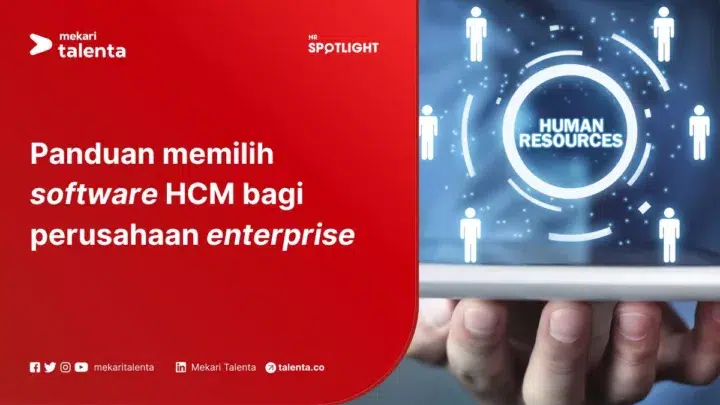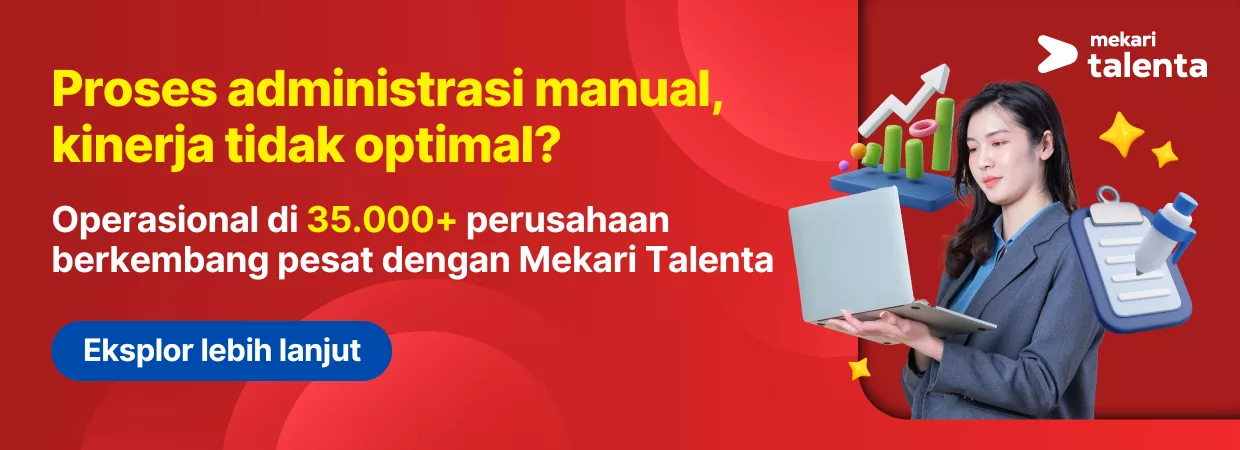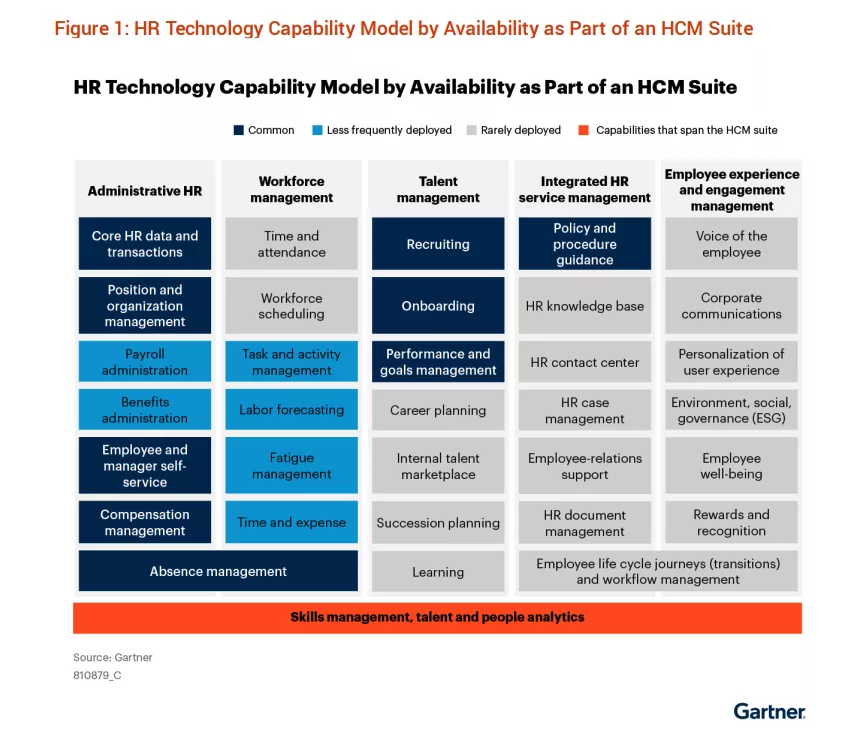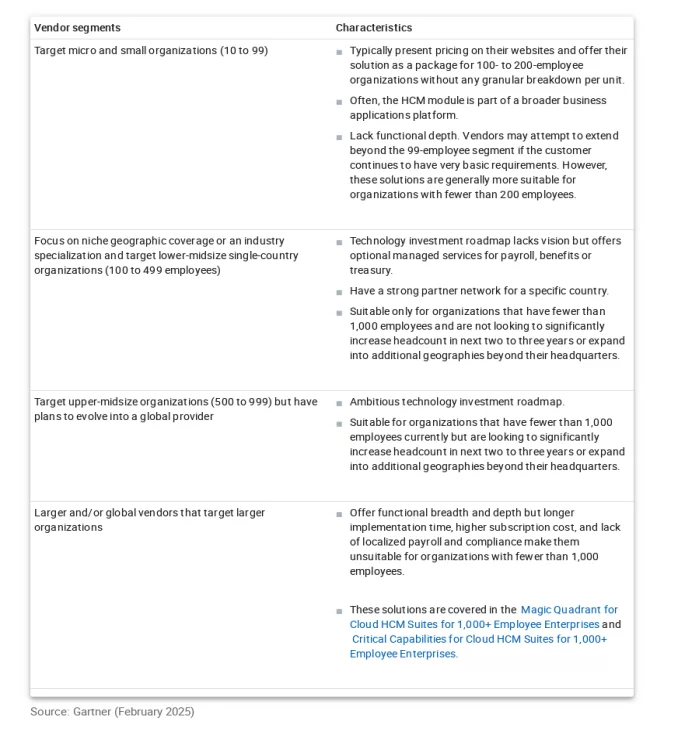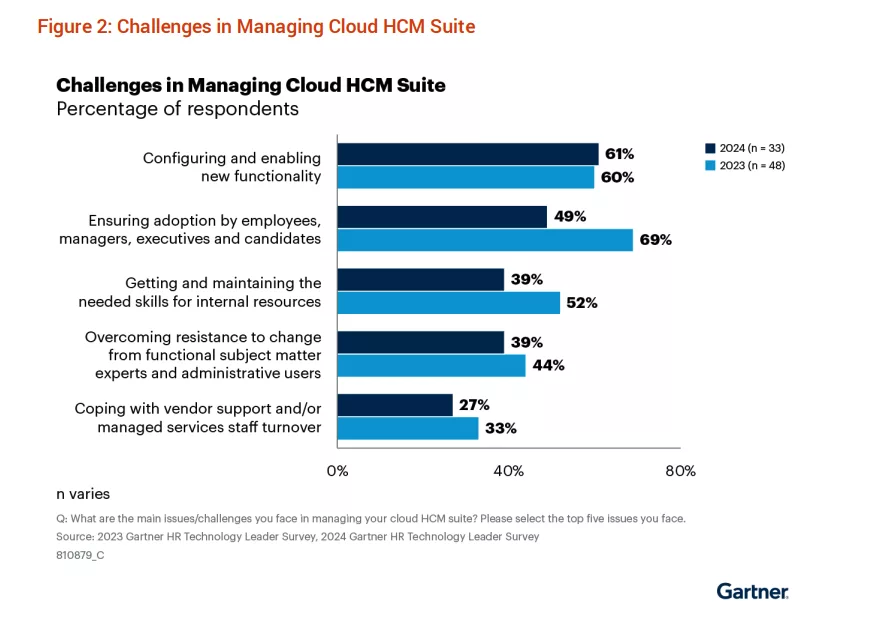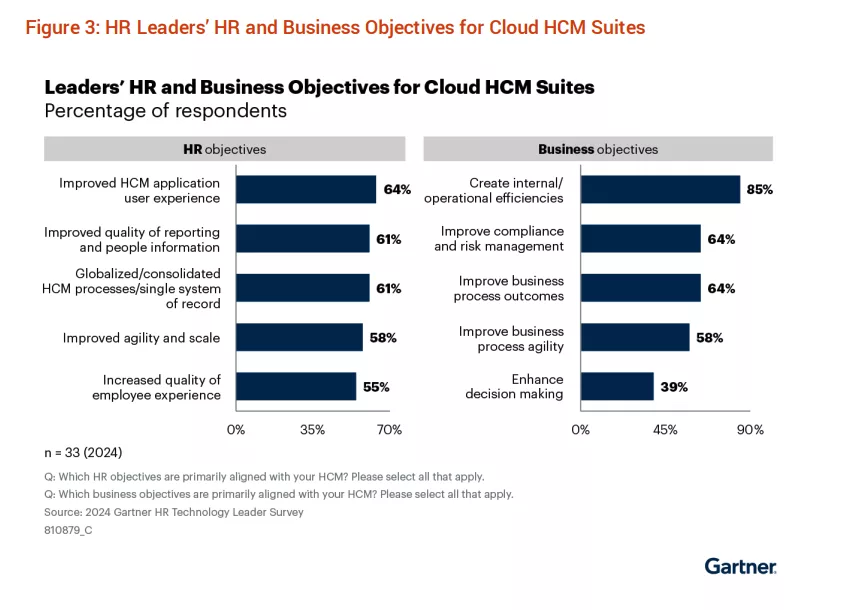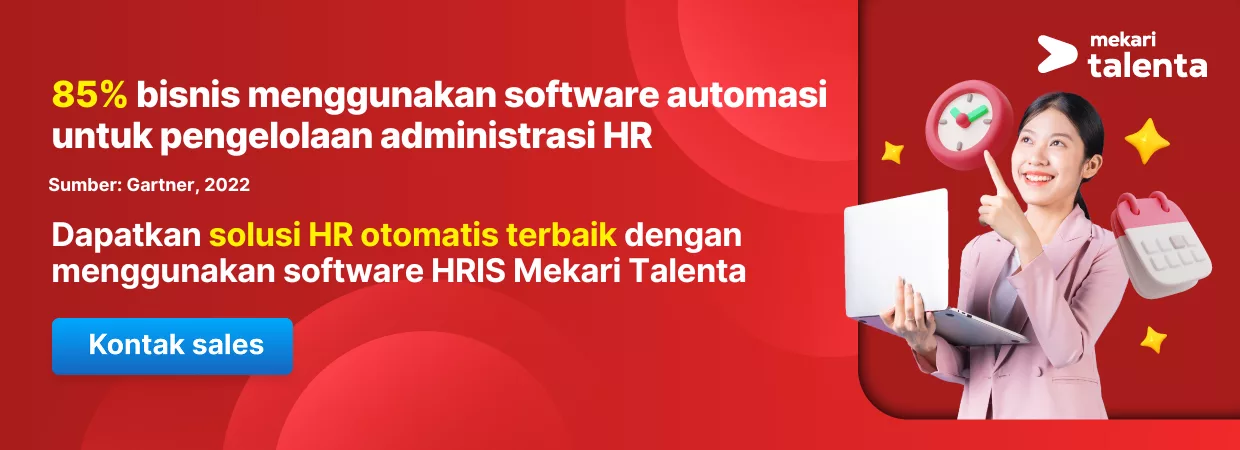Di zaman sekarang, banyak HR yang mendukung adanya investasi di penggunaan teknologi HCM yang baik, terutama pada perusahaan enterprise dengan karyawan 1.000 orang atau kurang.
Mereka memprioritaskan beberapa hal termasuk return on investment (ROI), regulasi di negara setempat, dan juga dukungan dari customer service.
Lewat artikel ini, Mekari Talenta akan memberikan panduan untuk memilih HCM terbaik berdasarkan rekomendasi dari Gartner. Simak penjelasannya berikut ini.
Baca Juga: 25 Software Cloud HCM Terbaik: Solusi untuk Manajemen Tenaga Kerja
Apa pentingnya implementasi HCM di perusahaan?
Tujuan HR dan tujuan bisnis untuk portofolio teknologi SDM sering kali berbeda, yang memperumit tugas pemimpin HR di perusahaan dalam memilih software human capital management (HCM) berbasis cloud.
Mereka harus menyeimbangkan beragam tujuan perusahaan, yang sering kali menghasilkan keputusan buruk dan penyesalan pembelian terhadap software HCM yang tinggi.
Adopsi teknologi ini masih menjadi tantangan karena kompleksitas dalam konfigurasinya, resistensi terhadap perubahan dari peran penggunanya, dan kekurangan sumber daya internal dengan keterampilan yang dibutuhkan.
Perusahaan mungkin saja menghadapi keterbatasan anggaran HR dan kesulitan untuk menggambarkan potensi dari implementasi HCM.
Maka dari itu, para pemimpin HR di perusahaan enterprise yang ingin mengimplementasikan HCM dengan tepat harus mempertimbangkan hal ini:
- Selaraskan investasi software HCM dengan tujuan perusahaan sebagai respons terhadap perubahan kebutuhan bisnis. Evaluasi bagaimana penyedia software atau vendor dapat menyediakan kapabilitas yang menjawab prioritas SDM saat ini dan di masa depan, seperti meningkatkan pengalaman karyawan, memperbaiki kualitas dan pelaporan data, serta menstandarkan proses HR.
- Tingkatkan keselarasan antara software baru dengan prioritas yang terus berkembang dengan menilai keberlanjutan jangka panjang setelah memilih vendor, visi masa depan dan roadmap-nya, momentum pelanggan, serta layanan yang ditawarkan. Pertimbangkan variabel-variabel ini terhadap proyeksi pertumbuhan jumlah karyawan dan kesiapan organisasi dalam menghadapi perubahan digital.
- Pilih solusi yang sesuai dengan mengevaluasi rekam jejak mereka dalam memberikan nilai bisnis pada proyek-proyek yang selaras dengan penggunaannya, khususnya penerapan AI praktis dan kemampuan implementasi yang cepat.
Setelah mempertimbangkan faktor-faktor tersebut, organisasi dapat mulai mengidentifikasi vendor yang mampu menyediakan solusi HCM berbasis cloud secara komprehensif serta relevan dengan kebutuhan bisnis jangka panjang.
Dalam proses evaluasi tersebut, perusahaan dapat mempertimbangkan solusi HRIS Enterprise dari Mekari Talenta sebagai salah satu alternatif yang dirancang untuk mendukung implementasi HCM end-to-end pada perusahaan berskala besar dengan struktur organisasi yang kompleks.
Baca juga: Panduan Lengkap Perencanaan Sumber Daya Manusia (SDM) di Perusahaan
Indikator HCM yang baik menurut Gartner
Gartner mendefinisikan human capital management (HCM) suites untuk perusahaan regional dengan jumlah karyawan di bawah 1.000 sebagai rangkaian aplikasi berbasis cloud yang menyediakan fungsionalitas untuk menarik, mengembangkan, melibatkan, mempertahankan, dan mengelola karyawan.
Fungsi-fungsi software HCM mencakup:
- Mengelola data historis organisasi dan karyawan, proses siklus karyawan, serta layanan mandiri transaksional bagi karyawan dan manajer.
- Menarik dan mempertahankan talenta melalui sourcing, pelacakan pelamar, orientasi (onboarding), manajemen kinerja, dan pelatihan.
- Mengelola struktur perusahaan melalui penciptaan, perencanaan, dan pembatasan posisi karyawan serta mencatat data tenaga kerja berdasarkan posisi yang diberikan.
- Mengelola penempatan operasional pekerja bergaji dan pekerja per jam untuk mencatat waktu kerja dan ketidakhadiran.
- Menyediakan bantuan untuk perusahaan untuk mengelola regulasi peraturan terhadap undang-undang ketenagakerjaan dan perjanjian yang berkaitan dengan tempat penyimpanan data.
Fitur Wajib HCM
- HR Administratif: Data karyawan, struktur organisasi, transaksi siklus hidup kerja, layanan mandiri berbasis peran, administrasi penggajian dan tunjangan. Bisa juga mencakup manajemen ketidakhadiran, kesehatan dan keselamatan, serta fitur tambahan lainnya.
- Manajemen Talenta: Rekrutmen, onboarding, manajemen kinerja, perencanaan kompensasi, pembelajaran, dan pengembangan keterampilan.
- Manajemen Tenaga Kerja: Administrasi kehadiran dan waktu kerja, serta penjadwalan. Bisa juga mencakup pelacakan tugas dan aktivitas, perencanaan anggaran, prediksi, manajemen kelelahan, dan peningkatan pengalaman pekerja garis depan.
- Manajemen Layanan HR Terintegrasi: Akses langsung dan personal ke kebijakan, prosedur, dan panduan program untuk karyawan dan manajer. Mungkin juga mencakup manajemen kasus terintegrasi, basis pengetahuan, manajemen dokumen digital, asisten virtual, dan manajemen alur kerja.
- Pengalaman Karyawan (Employee Experience): Termasuk fungsi-fungsi untuk mendukung pengalaman kerja, seperti suara karyawan (voice of the employee), kesejahteraan karyawan, pelatihan dan pendampingan, kampanye karyawan, serta penghargaan dan pengakuan.
- Kapabilitas Pendukung Lintas Fungsi: Kapabilitas ini menggunakan data dari interaksi fitur-fitur di atas, dan semakin sering diintegrasikan ke dalam HCM suite. Contohnya termasuk talent analytics, asisten virtual HR (HRVA), dan kapabilitas pasar talenta internal.
- Implementasi AI: Termasuk machine learning, pemrosesan bahasa alami (natural language processing), generative AI, graph technology, dan teknologi AI lainnya untuk meningkatkan proses HR dan pengalaman karyawan.
Baca juga: 9 Tantangan Rekrutmen di Tahun Ini dan Solusi untuk Mengatasinya
Market Guide HCM
Pasar untuk HCM suites terfragmentasi dalam beberapa bagian karena kebutuhan perusahaan sangat bervariasi tergantung pada ukuran dan struktur, lokasi geografis, serta industrinya.
Oleh karena itu, para vendor mengembangkan produk yang ditargetkan untuk kombinasi spesifik dari lokasi geografis, ukuran organisasi, dan tingkat kompleksitas.
Karena perbedaan dalam preferensi terhadap berbagai fungsionalitas, tingkat kompleksitas, dan titik harga, sebuah produk yang dirancang untuk organisasi dengan 10.000 karyawan atau lebih tidak akan cocok untuk organisasi dengan 100 karyawan dan begitu pula sebaliknya.
Panduan ini mencakup HCM suites yang dirancang untuk perusahaan enterprise. Berikut gambar Magic Quadrant dari Gartner yang bisa dijadikan panduan.
Dapat dilihat dari tabel di atas bahwa fitur yang berkaitan dengan fungsi administratif HR dan manajemen talenta menjadi fitur yang paling umum dimiliki oleh kebanyakan software HCM.
Segmentasi vendor berdasarkan karakteristik perusahaan
Tantangan dalam mengelola HCM Suite
Meskipun HCM telah mencapai tingkat adopsi yang lebih luas, HR tetap menghadapi berbagai tantangan dalam hal penerapan dan realisasi nilai.
Beberapa hambatan berasal dari dalam organisasi itu sendiri, seperti kesulitan dalam mendapatkan sumber daya dengan keterampilan yang diperlukan.
Namun, banyak juga kelemahan yang berasal dari pihak vendor, seperti tidak memenuhi komitmen dukungan serta tidak menyediakan platform yang intuitif untuk perubahan konfigurasi dan integrasi.
Gambar berikut menunjukkan lima tantangan utama yang dihadapi organisasi dalam mengelola HCM. Para pembeli perlu mempertimbangkan tantangan-tantangan ini saat melakukan evaluasi vendor.
Meskipun lima tantangan teratas tetap sama seperti pada tahun 2023, urutannya berubah di tahun 2024. Misalnya, konfigurasi dan pengaktifan fungsionalitas baru tetap menjadi tantangan signifikan, sebagaimana dilaporkan oleh 61% responden dari Gartner.
Masalah ini semakin penting karena meningkatnya kebutuhan untuk beradaptasi dengan perubahan regulasi serta pembaruan vendor yang mendukung teknologi baru.
Tantangan kedua adalah memastikan adopsi oleh karyawan, manajer, eksekutif, dan kandidat, dengan 49% responden mengidentifikasinya sebagai kendala.
Angka ini turun secara signifikan dari 69% pada tahun sebelumnya, menunjukkan bahwa adanya peningkatan dalam wawasan berbasis data untuk manajer serta perbaikan dalam pemasaran kepada kandidat dan proses onboarding telah membantu mengurangi hambatan adopsi pada peran-peran tersebut.
Variasi dalam fitur yang ditawarkan
Vendor HCM suite memiliki beberapa area kekuatan dan kelemahan dibandingkan pesaing mereka. Beberapa memiliki cakupan pelokalan penggajian (payroll) yang lebih luas, sementara yang lain menawarkan teknologi akuisisi talenta yang lebih canggih atau lebih cocok untuk organisasi dengan proporsi besar pekerja bergaji per jam.
Selama proses evaluasi dan pemilihan vendor, pembeli harus menentukan sejauh mana fungsionalitas produk sesuai dengan kebutuhan dan prioritas organisasi mereka.
Misalnya, vendor yang berfokus pada perusahaan kecil cenderung tidak menyediakan manajemen talenta, manajemen tenaga kerja, manajemen layanan HR terintegrasi, serta kapabilitas pengalaman dan keterlibatan karyawan yang kuat. Mereka juga lebih jarang menawarkan beberapa aspek administratif HR seperti penggajian.
Pelanggan juga mungkin memilih untuk mengalihdayakan administrasi tunjangan dan/atau pemrosesan penggajian, atau tetap menggunakan sistem penggajian lama yang masih berbasis lokal (on-premise).
Organisasi dengan kurang dari 1.000 karyawan biasanya memiliki sumber daya yang lebih terbatas untuk menjaga integrasi, kualitas data, atau tugas administratif terkait teknologi HR.
Oleh karena itu, mereka sering memilih solusi terpadu dari satu sumber dibandingkan kedalaman fungsi, demi meminimalkan usaha integrasi dan administrasi.
Baca juga: Employee Engagement: Definisi, Faktor, dan Strategi Tepat Meningkatkannya
Menyeimbangkan Tujuan HR dan Bisnis
Dalam survei yang dilakukan Gartner, responden menyebutkan dua set tujuan yang berbeda yakni tujuan bisnis dan tujuan HR saat ditanya mengenai alasan di balik investasi teknologi HCM.
Tujuan bisnis lebih berfokus pada proses pragmatis seperti efisiensi serta manajemen kepatuhan dan risiko, sedangkan tujuan HR lebih bersifat visioner dan mencakup peningkatan pengalaman karyawan dan kualitas pelaporan.
Mekari Talenta satu-satunya vendor dari Indonesia untuk pasar Asia
Gartner telah menyajikan 40 vendor HCM yang dikelompokkan berdasarkan wilayah kantor pusat masing-masing vendor.
Dari 40 vendor HCM rekomendasi, Mekari Talenta satu-satunya vendor dari Indonesia yang disebutkan Gartner sabagai salah satu representasi untuk wilayah Asia Pasifik dan Jepang.
Dari perspektif fungsional, setiap vendor yang tercantum setidaknya menawarkan HR inti dan manajemen talenta yang disediakan sebagai software HCM. Tak terkecuali Mekari Talenta.
Seperti vendor HCM lainnya, Mekari Talenta menawarkan fungsi penggajian, administrasi tunjangan, manajemen tenaga kerja, fungsi ERP, serta implementasi di lokasi (on-premises) yang komprehensif.
Riset ini secara eksklusif berfokus pada solusi HCM berbasis cloud, karena merupakan opsi implementasi yang paling umum.
Berdasarkan Magic Quadrant for Cloud HCM Suites for 1,000+ Employee Enterprises oleh Gartner, vendor-vendor ini juga memiliki basis pelanggan yang signifikan dari perusahaan dengan kurang dari 1.000 karyawan.
Itulah tadi rangkuman terkait market guide pemilihan HCM untuk perusahaan yang dilakukan oleh Gartner.
Bagi Anda yang ingin mencari vendor HCM terbaik yang sesuai dengan kebutuhan Anda, ada baiknya memperhatikan beberapa hal berikut ini:
- Selaraskan kebutuhan perusahaan dengan manfaat teknologi yang diberikan HCM. Contohnya termasuk meningkatkan kualitas data dan pelaporan, meningkatkan kemampuan pengalaman karyawan, dan menstandarkan proses SDM untuk mendorong efisiensi operasional serta kelincahan organisasi.
- Tingkatkan keselarasan dengan prioritas yang terus berkembang dengan mengevaluasi vendor berdasarkan yang memiliki roadmap jelas serta layanan pelanggan yang baik seiring dengan proyeksi pertumbuhan jumlah karyawan organisasi Anda. Nilai solusi HCM berdasarkan kriteria utama seperti kemudahan integrasi, efektivitas biaya, dan waktu menuju produktivitas untuk mengidentifikasi teknologi yang paling tepat untuk diinvestasikan.
- Pilih vendor yang tepat dengan mengevaluasi rekam jejaknya dalam memberikan ROI dari proyek-proyek sebelumnya. Cegah frustrasi selama implementasi dengan menilai strategi pelatihan yang disesuaikan dari vendor dan dukungan manajemen perubahan, yang sangat penting untuk keberhasilan implementasi dan penggunaan oleh perusahaan nantinya.
Kemudian jika Anda tertarik dengan mengeksplorasi fitur-fitur lain dari Mekari Talenta, Anda bisa menghubungi tim sales kami sekarang juga dan mendiskusikan kebutuhan Anda.
Referensi:
Gartner, Market Guide for Cloud HCM Suites for Regional and/or Sub-1,000 Employee Enterprises
